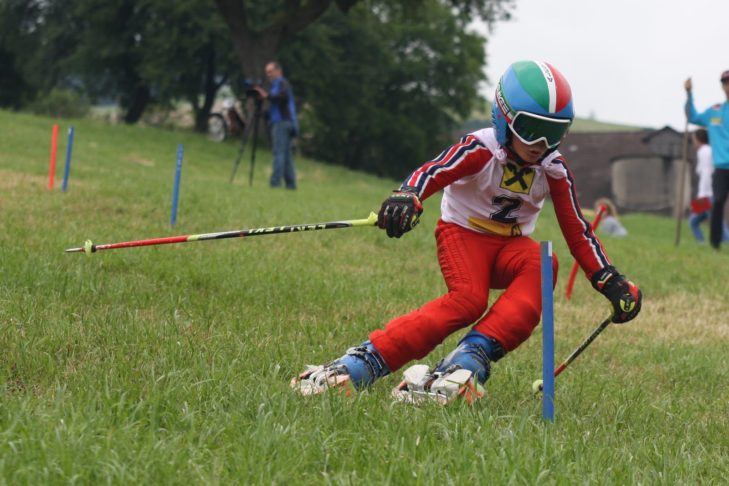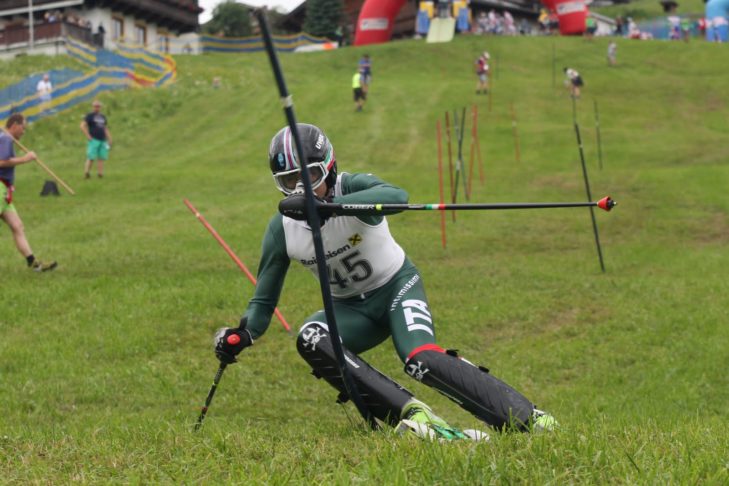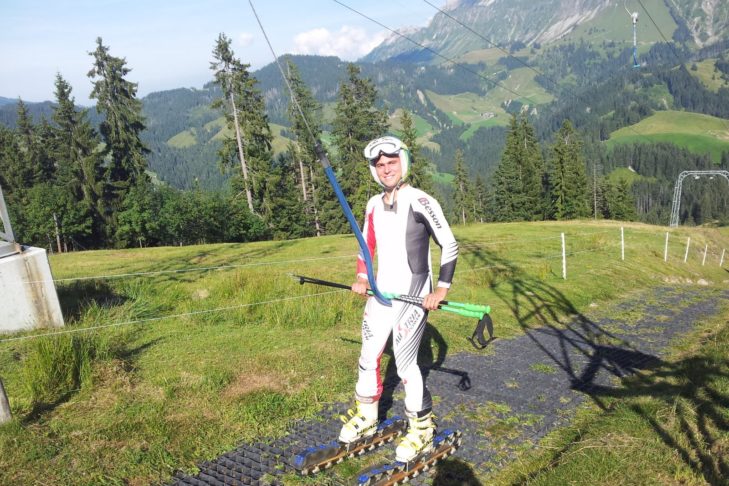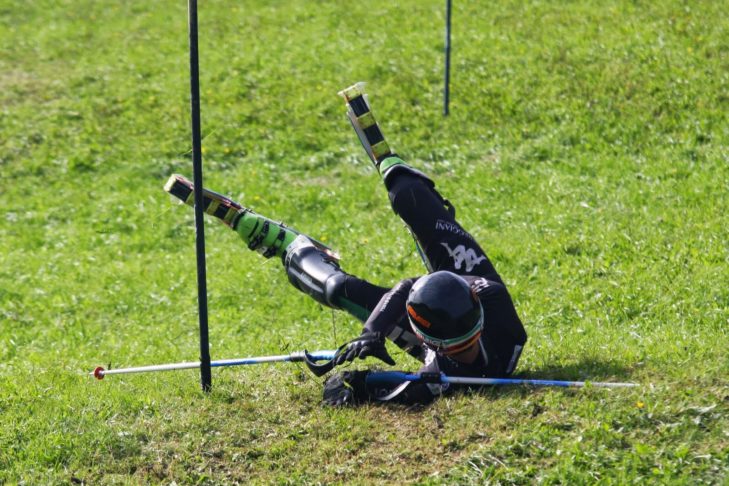When Josef Kaiser from Germany had the idea in 1960 that it would be possible to ski on special boards in summer, the foundation stone of grass skiing was laid. In the following years, the summer sport became so popular that even world championships, world cup races and national competitions are now held on grass skis. So what is it that makes grass skiing so special? SnowTrex has the details.
This is what grass skis look like
Grass skis are 60 to 100 cm long and about 12 cm high. In contrast to Alpine skis, they are not a relatively flat board, but consist of two rollers connected by an axle. Above the rollers runs the so-called base, which consists of a belt with sliding elements – just like a tracked vehicle, only smaller. The skis are bent slightly upwards at the front and rear. The stirrup binding on the grass ski is similar to the construction known from big foot skis. On these constructions, grass skiers can ski downhill at speeds of up to 90 or 100 km/h. The ski boots are again the same as those known from alpine skiing. Grass skis are cared for by cleaning them properly and oiling them occasionally.
The technique of grass skiing
Grass skiing – as the name suggests – is done on grass or a mown meadow. For more than 20 years, the sport has been integrated into the International Ski Federation (FIS), which also determines the rules for the competitions. The same disciplines are distinguished here as in alpine skiing: slalom, giant slalom, super G, downhill and parallel competitions.
The technique and turns are identical to those of alpine skiers. Due to the lack of snow, however, it is not possible to ski a snow plough or slide sideways. Thus, grass skiing is very similar to carving.
Grass skiing facilities
Since grass skiing cannot be slowed down like alpine skiing, the slopes are usually much flatter. In order to come to a standstill, grass skiers have to swing off in a curve and ultimately roll out. Abrupt braking is impossible. For safety reasons, a ski helmet, gloves and ski goggles are therefore strongly recommended.
Generally speaking, you can ski wherever there are grass-covered slopes. For example, there are grass ski races in Hamburg and Berlin. A ski lift, which can also be used in summer, is, of course, particularly advantageous for the athletes, as in alpine skiing. Alternatively, transportable baby lifts are sometimes installed. Those who live in the flat country and still like to ski can also stretch a kite in front of the grass skis.
Grass skiing season
The season for grass skiers lasts from the end of April to the end of September. Originally, grass skis were also intended as summer training equipment for winter sports fans. With grass skis, they could stay fit throughout the summer and further refine their technique. However, this idea did not catch on. What emerged was a summer sport with athletes and hobby skiers specialising in it.
Grass skiing competitions
In 1971, a European Cup in grass skiing was held for the first time, followed by European Championships in 1976. In 1979, the World Championships were added every 2 years (since 1990 also the Junior World Championships) and the European Cup was finally replaced by the World Cup in 2000. Today, there is also a 5-part racing series, the German Cup, which is equivalent to the German championships. In 1976, the sport of grass skiing even received its own section in the German Ski Association (DSV), and in 1985, the International Ski Federation FIS followed suit.
Please also note that by using our services and integrating the YouTube API Services, the YouTube Terms of Service and the YouTube API Services Terms apply and your use of our website is deemed to be acceptance of these terms.
4 questions for a professional grass skier
Michael Bernshausen was a grass skier for 15 years and today, with his company midiafilm, he not only shoots grass ski videos, but especially ski films with top freeriders like Roman Rohrmoser, Felix Wiemers and Sebastian Hannemann. We asked him some questions about grass skiing.
How do you get into grass skiing in the first place? Are most grass skiers also skiers?
When I was 12 years old, I absolutely wanted to try it out. My two older brothers also used to ride, so I was always keen on the sport from a very early age. As a grass skier, you definitely have some skiing experience. Certainly there are exceptions, but most of them have already gained experience in alpine racing or in the annual winter skiing holiday.
What is the attraction of this sport for you?
Ski racing was the most exciting thing for me. The winter in our area was not always optimal and the journey to the Alps was very long over time. This way, you have the opportunity to be on skis all year round. After all, grass skiing is possible on almost every mowed meadow with a little gradient. I also always liked the fact that there is generally a nice and friendly atmosphere in the small grass ski family.
What is it like to go down the mountain on grass skis?
In short: just like skiing, going down a slope at speed. The only difference is that it is not cold, but warm. In addition, you feel every bump and change in the terrain while skiing – for example, when the weather conditions are different and variations range from soft meadows to hard motorways.
The two sports, skiing and grass skiing, are otherwise very similar in terms of technique and movement. In grass skiing, just as in snow, you try to get to the edge to make a turn. We just can’t slide or sliding is not really helpful. In return, this also means that we have to use every turn – also for braking.
Don’t you feel terribly afraid if you can’t brake quickly enough?
I wouldn’t call it fear. Maybe a conscious respect. You should simply have a plan B for some situations. It always depends on the slope. You don’t ski mindlessly down the mountain, but you are aware that at some point you have to stop. However, there are also slopes on which braking is not very difficult. If there are enough run-off zones, you can accelerate without any problems.
Our conclusion: If you don’t want to give up skiing at the end of the winter season, you should try grass skiing. Apart from that, there are some ski resorts in Europe where skiing is also possible in summer.
FAQs about grass skiing
What are grass skis?
Grass skis are special skis with which you can ski on meadows and therefore in summer.
What do grass skis look like?
Grass skis are between 60 and 100 cm long. In contrast to alpine skis, they are also not flat, but about 12 cm high. This is because they consist of rollers, over which a belt with sliding elements is placed. They resemble a tracked vehicle, but are much smaller.
How do you ski on grass?
The technique of grass skiing is very similar to the technique of alpine skiing. However, due to the lack of snow, it is not possible to perform a snow plough or slide sideways.
Where can you go grass skiing?
Austria in particular has several facilities for grass skiing, such as in Aschau im Zillertal, in Zell am See-Kaprun or in Schwarzenbach, for example.








